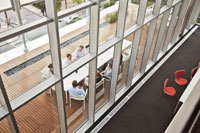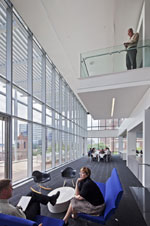Perkins + Will Atlanta Headquarters

Aluminum extrusions play a vital role in the renovation of this building for Perkins + Will ... and the achievement of a landmark LEED rating.
Transforming an existing building into a sustainable design requires careful analysis of how materials such as extruded aluminum work with technology to achieve high efficiency and dramatically reduce carbon emissions.
Perkins + Will Architect's 1315 Peachtree office building, originally constructed in 1985 in Atlanta, Georgia, is a superb example of such a retrofit, earning the highest LEED (Leadership in Energy and Environmental Design) Platinum rating in the Northern Hemisphere with 95 points. The project achieved landmark energy savings by offsetting carbon emissions, investing in renewable energy technologies and continuously monitoring real-time internal and external systems performance. The carbon neutral building focuses on improving the environment through regenerative design. Photovoltaics and rooftop twin microturbines help reduce its carbon footprint by 68 percent.
Bruce McEvoy, LEED AP, BD + C, a key strategy of sustainable design philosophy is systems thinking and eliminating waste. "It is the systems thinking applied to the whole that creates a high-performance building," McEvoy stresses. "Aluminum extrusions are recyclable and very efficient, which is why they show up throughout the project. Aluminum is part of the products and components that helped us achieve our ambitious sustainability goals."

Extruded aluminum products were integrated throughout 1315 Peachtree to help achieve sustainable design, including curtainwall systems on the west, east and south facades; horizontal air foils to shade the west side of the building from mid-day sun; racked airfoils above the terrace trellis to shade the building's fifth and sixth floors; terrace guard rail caps; interior demountable wall structures; interior benching systems; and interior LED light fixture housings.
McEvoy emphasizes that the greatest challenge of the project was the building's west facade. Substantial heat gain from low-angle sun in the late afternoon and high-angle sun in the early afternoon required two shading strategies. The first focused on floors two, three and four. McEvoy explains, "Shading design for these floors incorporated vertical glass fins to our aluminum extrusions, which allowed us to choose a frit pattern that shades the building in late afternoon, while preserving views up and down Peachtree Street (Atlanta's main corridor). We then added horizontal air foils that stand off of the glass fins to shade the building in early afternoon from higher altitude sun."
The second shading strategy uses an external, kinetic sun shade and trellis above the terrace at the fifth and sixth floors. "The sun shade is tied to our building controls, and drops incrementally throughout the afternoon to shade low-angle sun. High-angle sun is blocked by horizontal air foils racked on the top structure of our new trellis, creating a modern interpretation of a southern porch," said McEvoy.

Inside, demountable wall structures are used in the Perkins + Will offices on the top four floors, allowing flexibility while eliminating future waste if the building is repurposed. General and accent lighting are housed in dual-functioning aluminum extrusions, providing a tailored appearance while dissipating heat from the circuit boards. LED fixtures eliminate energy need wherever possible, while efficient use of daylighting reduces energy use for lighting by 67 percent over comparable buildings.
McEvoy believes aluminum extrusions are just as viable in renovations as they are in new construction. "For flexible interior work spaces required by today's dynamic workforce, the ability to provide options and reconfigurability are key. Demountable systems, furniture systems and improving the building envelope with new curtainwall will allow repurposing of existing building stock. Aluminum extrusions provide a very precise and tailored look. Although aluminum has an attractive natural finish, possible coatings and finishes make aluminum extrusions appealing to designers."
McEvoy sums up: "Performance, efficiency and aesthetics will ensure aluminum extrusions are incorporated into building product components today and in the future. Their use in conjunction with the whole is what matters. Extruded aluminum offers efficiency, recyclability and great structural characteristics. How we choose to use it is the true opportunity for better design."
Photos © Eduard Hueber/archphoto.com
 -
-




 |
|